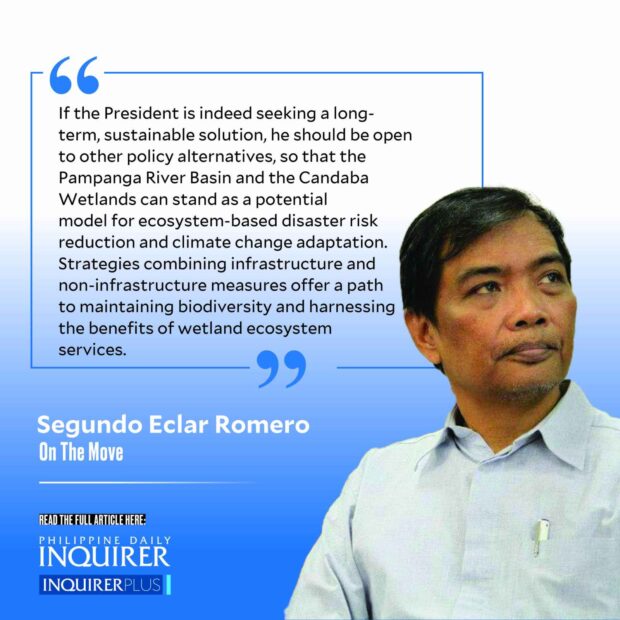Leave Candaba alone
 The Candaba wetlands in the Philippines, nestled in the intersection of Pampanga, Bulacan, and Nueva Ecija within the Pampanga River Basin, are a hidden gem. The wetlands span 32,000 hectares, encompassing ponds, swamps, marshes, and grasslands. Seasonal shifts dictate land use, from rice and crop planting to serving as a natural flood retention basin during rainy months.
The Candaba wetlands in the Philippines, nestled in the intersection of Pampanga, Bulacan, and Nueva Ecija within the Pampanga River Basin, are a hidden gem. The wetlands span 32,000 hectares, encompassing ponds, swamps, marshes, and grasslands. Seasonal shifts dictate land use, from rice and crop planting to serving as a natural flood retention basin during rainy months.
The wetlands’ avian diversity offers birdwatchers and nature lovers a vibrant experience. The declaration of Candaba as a bird sanctuary and the establishment of the Candaba Swamp Wildlife Reserve showcase efforts to protect the area’s avian diversity.
However, the provinces of Pampanga and Bulacan, plagued by frequent floods, have triggered a private sector-initiated, government-considered proposal to transform a portion of the Candaba wetlands into a floodwater impounding area.
While the impulse to mitigate flooding is understandable, the environmental cost of such an intervention is incalculable. The eruption of Mount Pinatubo has disrupted the region’s hydrology and, unbeknownst to many, is arguably the main culprit in the large-scale flooding in Pampanga and Bulacan. Climate change exacerbates these challenges, making flooding a recurring nightmare. Over the years, infrastructure projects have aimed to address flooding, such as floodways and protective dikes. The P900-million megadike project to armor Pampanga towns from lahar deposits has yet to fulfill its promise, and various ring dikes and other flood control measures of local government and residents have proved futile.
At first, the main threat to the Candaba wetlands was the proposal to drain and reclaim the area for more extensive agriculture. Now that floods are the main problem, the threat is the submergence of one-tenth of the wetlands as an impounding area for floodwater.
This proposed infrastructural intervention project is daunting. As proposed, a 200-hectare floodwater impounding area will be carved out of the Candaba wetlands. Assume that the retaining wall of this impounding area is five meters high, it can hold approximately 10 million cubic meters of water. Ten million cubic meters of water, if one meter high, would cover only an area of 10 square kilometers and may not have the flood-reduction impact expected from the project. How much would the eight-kilometer retaining wall of this impounding area cost? Also, for this impounding area to be effective, it should not absorb water from the mighty Pampanga River, which means that the riparian towns of Bulacan and Pampanga subject to flooding must be sealed from the river. Floodwater would also need to be pumped into the impounding area.
President Marcos has ordered the conduct of an extensive study on the proposed construction of a floodwater impounding system in the Candaba wetlands as a long-term solution to the flooding problem in Bulacan and Pampanga. Evaluating a single policy option is not sound. The President should enlarge the study to look into all possible options that consider the environmental, economic, technological, sociocultural, and political aspects. A larger, landscape-scale study is needed. It is clear that there is significant political and environmental opposition to the proposal. We should learn from the experiences of other countries. Japan’s Sendai River basin suffered catastrophic damage due to heavy rain and river channel alterations. It is clear that infrastructure projects can have unforeseen consequences.
Several non-hard infrastructure options should be considered, including rehabilitating the Pampanga River Basin’s watershed, planting suitable native species for riparian stabilization, and rehabilitating and extending the protective riparian dikes using environmentally sound engineering principles.
The agricultural value of the Candaba wetlands should not be discounted. The development and use of crop cultivars with a strong flood tolerance like the scuba rice that had been developed by the International Rice Research Institute could reinvigorate agriculture in naturally functioning wetlands like Candaba. Scuba rice is rice that can survive two weeks of complete submersion in floods, stay dormant, and thereafter recover to produce a reasonable yield. Such a strategy will make intrusive reclamation measures and the inordinate use of fertilizers and pesticides unnecessary.
If the President is indeed seeking a long-term, sustainable solution, he should be open to other policy alternatives, so that the Pampanga River Basin and the Candaba wetlands can stand as a potential model for ecosystem-based disaster risk reduction and climate change adaptation. Strategies combining infrastructure and non-infrastructure measures offer a path to maintaining biodiversity and harnessing the benefits of wetland ecosystem services.
doyromero@gmail.com




















